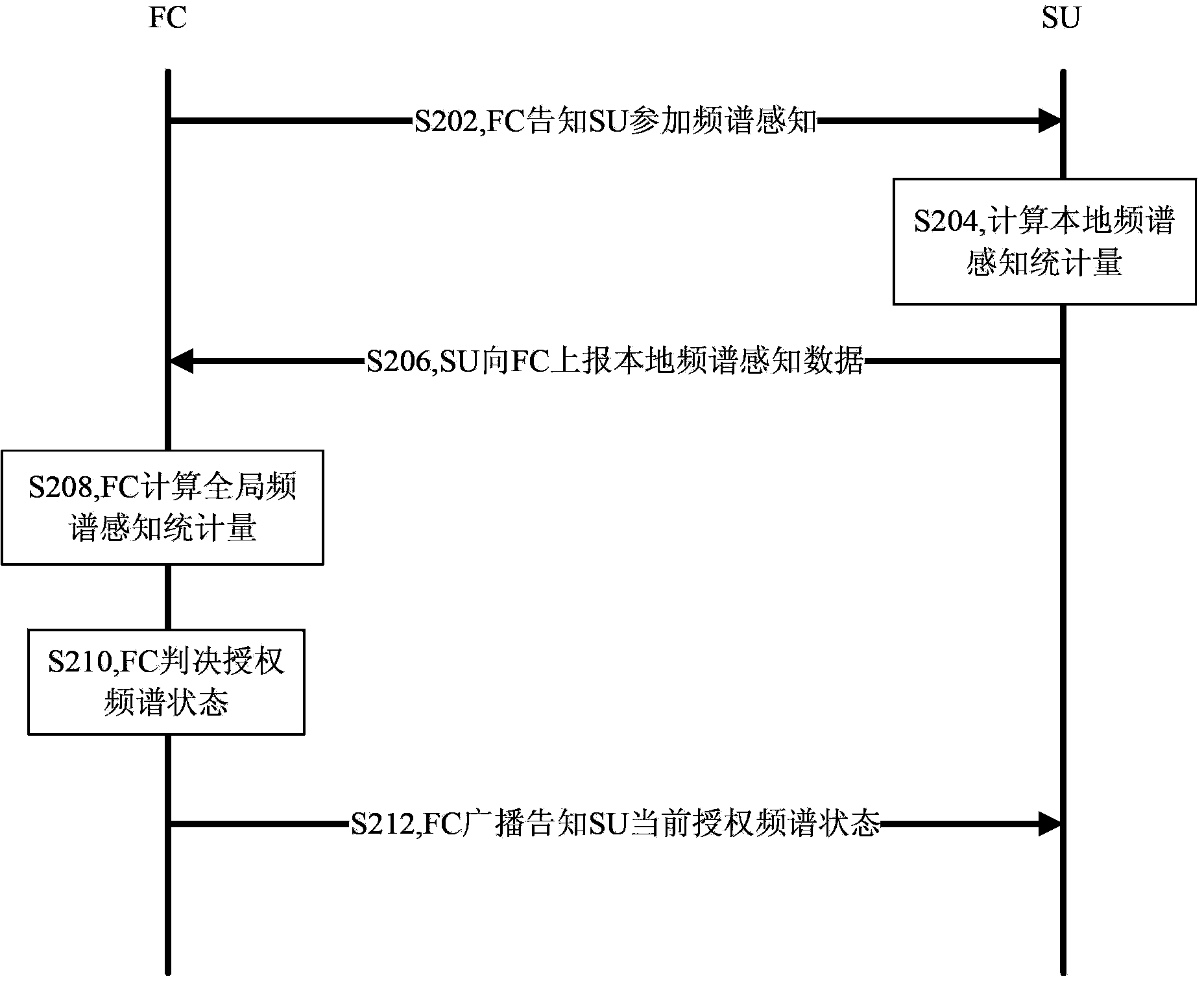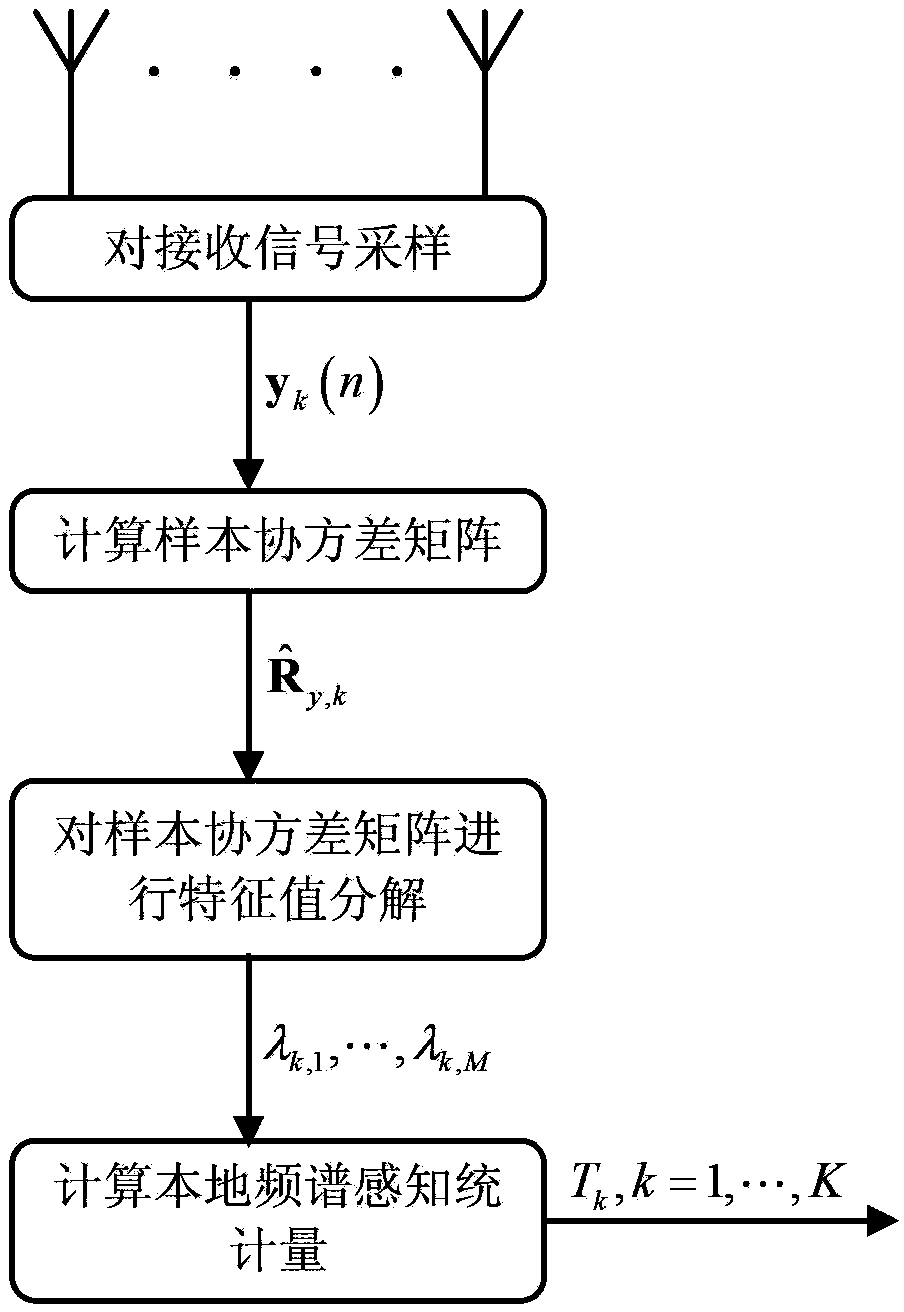Multi user cooperative frequency spectrum sensing data fusion method and device
A technology of collaborative spectrum sensing and data fusion, applied in transmission monitoring, electrical components, transmission systems, etc., can solve problems such as noise uncertainty, and achieve the effect of solving the problem of noise uncertainty and achieving excellent spectrum sensing performance.
- Summary
- Abstract
- Description
- Claims
- Application Information
AI Technical Summary
Problems solved by technology
Method used
Image
Examples
Embodiment 1
[0073] Step 1: Send spectrum sensing signaling.
[0074] In this step, the data fusion center notifies the 4 cognitive radio users within its coverage area to participate in spectrum sensing through the control channel (that is, K=4), and the number of antennas of each cognitive radio user is 4 (that is, M 1 =4, M 2 =4, M 3 =4, M 4 =4), the number of local signal samples corresponding to each cognitive radio user is 2160, 1080, 540, 270 (that is, N 1 =2160,N 2 =1080, N 3 =540, N 4 =270).
[0075] Step 2, calculating local spectrum sensing statistics.
[0076] In this step, the four cognitive radio users participating in spectrum sensing perform local spectrum sensing in the sensing time slot, and calculate their respective local spectrum sensing statistics T 1 ,T 2 ,T 3 ,T 4 .
[0077] First, the four cognitive radio users participating in spectrum sensing sample the received signal, and obtain the signal sample vector y corresponding to the four cognitive radio us...
Embodiment 2
[0094] Step 1: Send spectrum sensing signaling.
[0095] In this step, the data fusion center notifies the 4 cognitive radio users within its coverage area to participate in spectrum sensing through the control channel (that is, K=4), and the number of antennas of each cognitive radio user is 8, 6, 4, 2 ( i.e. M 1 =8, M 2 =6, M 3 =4, M 4 =2), the number of local signal samples corresponding to each cognitive radio user is 270 (that is, N 1 =270,N 2 =270,N 3 =270,N 4 =270).
[0096] Step 2, calculating local spectrum sensing statistics.
[0097] In this step, the four cognitive radio users participating in spectrum sensing perform local spectrum sensing in the sensing time slot, and calculate their respective local spectrum sensing statistics T 1 ,T 2 ,T 3 ,T 4 .
[0098] First, the four cognitive radio users participating in spectrum sensing sample the received signal, and obtain the signal sample vector y corresponding to the four cognitive radio users 1 (1),......
Embodiment 3
[0115] Step 1: Send spectrum sensing signaling.
[0116] In this step, the data fusion center notifies the 4 cognitive radio users within its coverage area to participate in spectrum sensing through the control channel (that is, K=4), and the number of antennas of each cognitive radio user is 4 (that is, M 1 =4, M 2 =4, M 3 =4, M 4 =4), the number of local signal samples corresponding to each cognitive radio user is 270 (that is, N 1 =270,N 2 =270, N 3 =270,N 4 =270).
[0117] Step 2, calculating local spectrum sensing statistics.
[0118] In this step, the four cognitive radio users participating in spectrum sensing perform local spectrum sensing in the sensing time slot, and calculate their respective local spectrum sensing statistics T 1 ,T 2 ,T 3 ,T 4 .
[0119] First, the four cognitive radio users participating in spectrum sensing sample the received signal, and obtain the signal sample vector y corresponding to the four cognitive radio users 1 (1),...,y 1 ...
PUM
 Login to View More
Login to View More Abstract
Description
Claims
Application Information
 Login to View More
Login to View More - Generate Ideas
- Intellectual Property
- Life Sciences
- Materials
- Tech Scout
- Unparalleled Data Quality
- Higher Quality Content
- 60% Fewer Hallucinations
Browse by: Latest US Patents, China's latest patents, Technical Efficacy Thesaurus, Application Domain, Technology Topic, Popular Technical Reports.
© 2025 PatSnap. All rights reserved.Legal|Privacy policy|Modern Slavery Act Transparency Statement|Sitemap|About US| Contact US: help@patsnap.com



